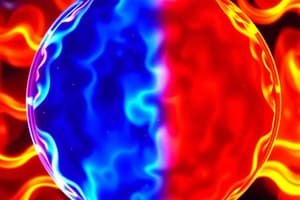Podcast
Questions and Answers
What does temperature measure?
What does temperature measure?
- Pressure of the particles in a gas
- Total energy within a substance
- Average kinetic energy of particles (correct)
- Energy transfer between objects
Heat and temperature are the same concept.
Heat and temperature are the same concept.
False (B)
What is the process called when a liquid loses heat and becomes a solid?
What is the process called when a liquid loses heat and becomes a solid?
Freezing
Sublimation is the process where a solid transitions directly into a _____ without becoming a liquid.
Sublimation is the process where a solid transitions directly into a _____ without becoming a liquid.
Match the phase changes with their descriptions:
Match the phase changes with their descriptions:
Which of the following best describes thermal equilibrium?
Which of the following best describes thermal equilibrium?
Dry ice melts into a liquid before becoming gas when exposed to room temperature.
Dry ice melts into a liquid before becoming gas when exposed to room temperature.
What is the temperature at which frost commonly forms on surfaces?
What is the temperature at which frost commonly forms on surfaces?
What is the process called when light is bent as it passes through a prism?
What is the process called when light is bent as it passes through a prism?
All wavelengths of light are refracted equally when passing through a prism.
All wavelengths of light are refracted equally when passing through a prism.
What is the SI unit for measuring temperature?
What is the SI unit for measuring temperature?
Heat always flows from the ______ object to the cooler object.
Heat always flows from the ______ object to the cooler object.
Match the following temperature scales with their common uses:
Match the following temperature scales with their common uses:
Which of the following terms refers to the balanced state of temperature in a system?
Which of the following terms refers to the balanced state of temperature in a system?
A joule is a unit used to measure temperature.
A joule is a unit used to measure temperature.
Define thermal equilibrium.
Define thermal equilibrium.
What does the coefficient of linear expansion (α) indicate?
What does the coefficient of linear expansion (α) indicate?
The formula for linear thermal expansion is given by ΔL = αL₀ΔT.
The formula for linear thermal expansion is given by ΔL = αL₀ΔT.
What happens to the atomic structure of a solid object when it is heated?
What happens to the atomic structure of a solid object when it is heated?
A material expands in size primarily due to an increase in ___ when it is heated.
A material expands in size primarily due to an increase in ___ when it is heated.
Match the following materials to their coefficients of linear expansion:
Match the following materials to their coefficients of linear expansion:
Which of the following correctly describes linear thermal expansion?
Which of the following correctly describes linear thermal expansion?
The change in length of an aluminum rod can be calculated using the same formula as for brass.
The change in length of an aluminum rod can be calculated using the same formula as for brass.
Calculate the change in length (ΔL) of a brass rod with an initial length of 2.31 m and a temperature change needed to achieve 18.9 x 10⁻⁴ m.
Calculate the change in length (ΔL) of a brass rod with an initial length of 2.31 m and a temperature change needed to achieve 18.9 x 10⁻⁴ m.
Flashcards are hidden until you start studying
Study Notes
Heat Transfer and Temperature
- Heat measures the energy transfer caused by temperature difference.
- Temperature measures the average kinetic energy of particles in a substance.
Thermal Equilibrium
- Thermal equilibrium occurs when objects in contact reach the same temperature.
- No net heat transfer occurs between objects in thermal equilibrium.
Phase Changes of Matter
- Melting: Heat is added to a solid, transitioning it to a liquid.
- Freezing: A liquid loses heat and solidifies.
- Evaporation (including boiling): A liquid absorbs heat, turning into a gas.
- Condensation: A gas loses heat and becomes liquid.
- Sublimation: A solid directly transitions to a gas.
- Deposition: A gas directly transitions to a solid.
Examples of Phase Changes
- Sublimation: Dry Ice (Solid Carbon Dioxide)
- Dry ice (CO₂) sublimates at temperatures above -78.5°C.
- It transitions directly from solid to gas, creating a visible fog.
- This is used for special effects like fog.
- Deposition: Frost Formation
- Frost forms when water vapor directly converts to ice crystals on surfaces below freezing.
- Water vapor loses energy and transitions from gas to solid.
Key Points
- Heat absorption or removal doesn’t always change a system's temperature, but it can change its phase.
Temperature
- Measures how hot or cold something is.
- Measures the average kinetic energy of particles.
- Units: Kelvin (K), Celsius (°C), Fahrenheit (°F), and Rankine (°R).
Thermal Energy
- Total energy due to particle motion and interactions.
- Faster particles mean greater kinetic energy and more thermal energy.
- Measured in joules (J).
Heat
- Energy transferred between systems with different temperatures.
- Flows from hotter to cooler objects until thermal equilibrium is reached.
Thermal Expansion
- Materials expand in size when heated.
- Linear Expansion: Increase in length.
- Areal Expansion: Increase in area.
- Volumetric Expansion: Increase in volume.
Linear Thermal Expansion
- Change in length (ΔL) is calculated as: ΔL = αL₀ΔT
- α is the coefficient of linear expansion (material-specific constant).
- L₀ is the initial length.
- ΔT is the change in temperature.
Light Bulbs
- Provide illumination in homes, streetlights, automobiles, theaters, and other applications.
Prisms
- Transparent objects with flat, polished surfaces.
- Refract light at different angles depending on wavelength.
- Shorter wavelengths are refracted more than longer wavelengths (chromatic dispersion).
- This creates a visible spectrum of colors (like a rainbow).
Studying That Suits You
Use AI to generate personalized quizzes and flashcards to suit your learning preferences.




